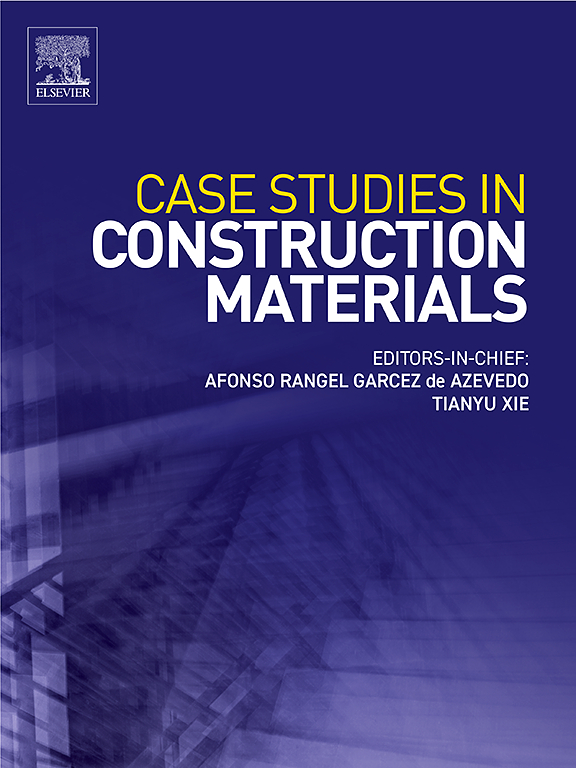Re – activation of recycled fly ash – based geopolymer binder to enhance mechanical properties
IF 6.6
2区 工程技术
Q1 CONSTRUCTION & BUILDING TECHNOLOGY
引用次数: 0
Abstract
This research delved into employment of thermal activation as a technique of enhancing the reactivity of recycled binders produced from parent hardened geopolymer systems. The production process involved crushing hardened fly ash – based geopolymer pastes and concretes, followed by milling the resulting powder to produce non – calcined or raw recycled binders, that were in turn exposed to various high temperatures of 250° to 550 °C, then used to prepare geopolymer paste mixtures at activator to binder ratio of 0.5. The alkali activator used was a combined solution mixture of sodium silicate and 12 M sodium hydroxide. The recycled binders produced were characterised using particle size /shape analysis, Brunauer – Emmett – Teller surface area measurements and thermogravimetry, prior to microanalyses. The synthesized paste mixtures were evaluated to determine their setting times and compressive strength values, followed by analytical studies done using X – Ray Diffraction, Fourier – Transform Infrared Spectroscopy and Scanning Electron Microscopy. Results showed that setting times of the raw or calcined recycled binder – based geopolymer mixtures were a drastic 70–90 % shorter than those of the control fly ash – based paste. It was found that calcination substantially enhanced geopolymeric reactivity of recycled binders, increasing the strengths of their mixtures by 36–54 %. Interestingly, mixtures that were synthesized using the paste – derived recycled binder calcined at the optimal 400 °C temperature, exhibited strength development that was similar or comparable to that of the control fly ash – based geopolymer paste.
对再生粉煤灰基地聚合物粘结剂进行再活化,提高其力学性能
本研究深入研究了热活化作为一种技术,以提高从母体硬化地聚合物体系中产生的回收粘合剂的反应性。生产过程包括粉碎硬化的粉煤灰基地聚合物膏体和混凝土,然后研磨所得粉末以生产未煅烧或再生原料粘合剂,然后将其暴露在250°到550°C的各种高温下,然后用于制备活化剂与粘合剂比为0.5的地聚合物膏体混合物。使用的碱活化剂是水玻璃和12 M氢氧化钠的复合溶液混合物。在进行微量分析之前,使用粒度/形状分析、布鲁诺尔-埃米特-泰勒表面积测量和热重法对所生产的回收粘合剂进行了表征。对合成的膏体混合物进行评估,以确定其凝结时间和抗压强度值,然后使用X射线衍射,傅里叶变换红外光谱和扫描电子显微镜进行分析研究。结果表明,生料或煅烧再生粘结剂基地聚合物混合物的凝结时间比对照粉煤灰基膏体缩短了70-90 %。研究发现,煅烧大大提高了回收粘合剂的地聚合物反应性,使其混合物的强度提高了36-54 %。有趣的是,使用膏体衍生的再生粘合剂在最佳400°C温度下煅烧合成的混合物显示出与对照粉煤灰基地聚合物膏体相似或相当的强度发展。
本文章由计算机程序翻译,如有差异,请以英文原文为准。
求助全文
约1分钟内获得全文
求助全文
来源期刊

Case Studies in Construction Materials
Multiple-
CiteScore
7.60
自引率
19.40%
发文量
842
审稿时长
63 days
期刊介绍:
Case Studies in Construction Materials provides a forum for the rapid publication of short, structured Case Studies on construction materials. In addition, the journal also publishes related Short Communications, Full length research article and Comprehensive review papers (by invitation).
The journal will provide an essential compendium of case studies for practicing engineers, designers, researchers and other practitioners who are interested in all aspects construction materials. The journal will publish new and novel case studies, but will also provide a forum for the publication of high quality descriptions of classic construction material problems and solutions.
 求助内容:
求助内容: 应助结果提醒方式:
应助结果提醒方式:


